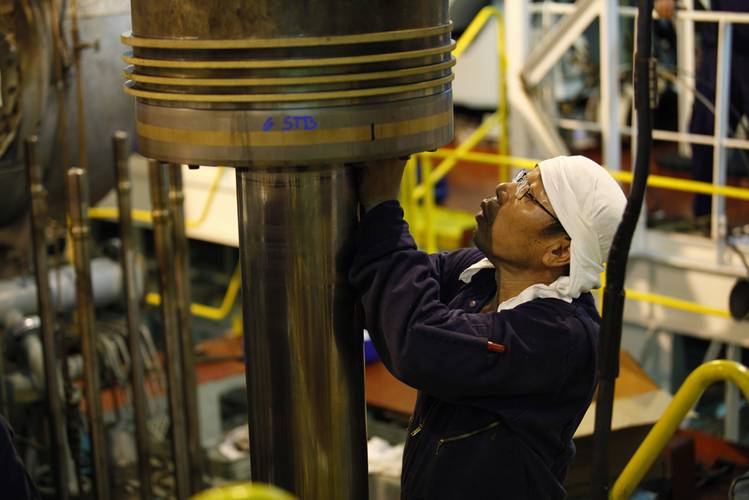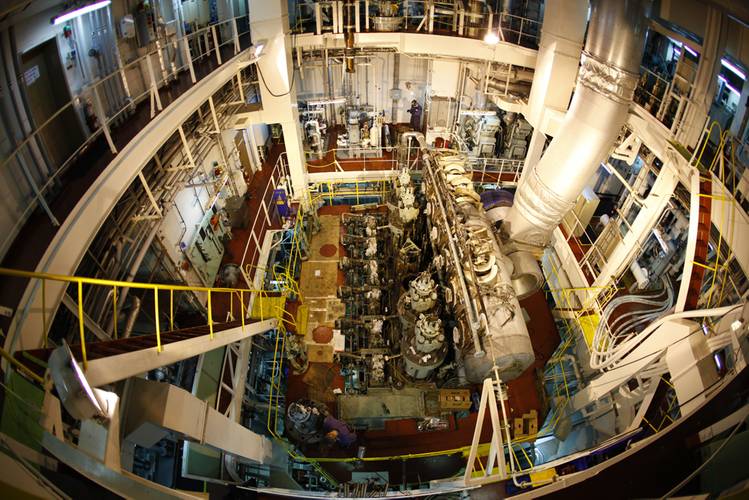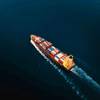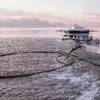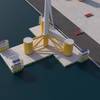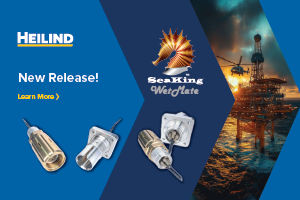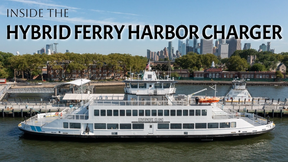Case Study: 6S50MC Main Engine Overhaul
The following is a look into the overhaul of a MAN B&W 6S50MC main engine onboard a tanker berthed in the Bahamas. The overhaul was performed by Transmarine Propulsion Systems, (TMPS) during a docking, the first major overhaul of the vessel’s engine which had 22,140 running hours. The objective of the overhaul was to make sure that all the cylinder units, once inspected and overhauled, would perform another trouble free period of ~20,000 running hours. Engine maintenance was conducted on the basis of two different methods of approach, Time Between Overhaul (TBO) and Condition Based Overhaul (CBO). Many owners and operators use TMPS to conduct engine services and component overhaul because TMPS works closely with customers to prepare service overhauls according to the actual engine condition, in many cases helping owners save money. TMPS inspects the condition of the components and engine in question extremely close. Their engineers talk with the Chief Engineer and the vessel’s owner to understand their needs, how their engines are operated and then makes recommendations on the TBO/CBO work to be done, often at a more beneficial cost than the OEM. This is all done without jeopardizing the engine performance and reliability, and it is a solution that is cost conscious and prepares the engine for future reliable operation.
The service work on this job was concentrated around Condition Based Overhaul (CBO) inspection/work of the combustion chamber related parts, as well as the major bearings and around Time Between Overhaul (TBO) inspection/work for the mechanical control gear, stay-bolts and the holding down bolts.
The CBO work for each cylinder unit consisted of:
1. Inspection and overhaul of the cylinder covers including the fuel- & starting valves located in the covers. According to the engine crew’s records, the exhaust valves were in a good condition. Thus, only one valve was inspected and found to be in good order, i.e. confirming the information from the crew. The cylinder covers cooling spaces were also inspected, cleaned and fitted back with new O-rings.
2. Pulling of the pistons for inspection, cleaning, calibration and overhaul based on the actual findings. The wear rates of all of the piston crowns but one, turned out to be approximately halfway towards the maximum wear limits. The one piston crown which had not yet met the maximum limits, but based on the actual wear would not be able to go back in the engine and perform another ~ 20,000 running hours without going beyond limits, was replaced. All pistons were assembled with new piston rings, O-rings and overhauled stuffing boxes.
3. The cylinder liners were cleaned, calibrated and honed in order to restore the liners running surfaces and remove ovality. As small-bore 2-stroke engines are more sensitive to ovality than their large-bore sister engines, this ensured that the piston rings perform better and this will lead to a better overall cylinder condition, compared to if honing had not been done. The cylinder liners cooling spaces were also inspected, cleaned and fitted back with new o-rings.
4. The fuel pumps were dismantled and replaced with overhauled pumps having new plunger/barrel units fitted. A worn plunger/barrel may be able to start on heavy fuel oil, but not always on the thinner diesel oil. In today’s world, were engines more and more have to change over to diesel oil during port calls, it is important to secure that starts can always take place.
5. Inspection of a representative amount of engine bearings was used as base for class approval of the remaining bearings without opening. The reason to avoid opening up bearings is, that statistics show most bearing damages come from human errors in connection with opening and closing for inspections. If certain parameters, such as bearing clearances and oil flow, are found to be normal then opening the bearings can be omitted.
The TBO work for the engine included.
1. Annual conditions check of the main chains and retightening.
2. Annual conditions check and tightening of stay-bolts, holding down bolts and side and end chocks.
3. Annual conditions check of the starting air distributor.
4. Annual conditions check of the crankcase relief valves.
5. Overhaul of the maneuvering system and the reversing and VIT-system for the fuel pumps. It is of importance to do such work at regular intervals of two years in order to ensure the ability to maneuver the engine safe at any time.
To ensure the quality of the service work, Transmarine Propulsion Systems Inc. used its own engineers, which all have more than 25+ years of experience in diesel engine service. Combining this experience with the customer’s fleet operation data and the experience available from the engine builder, provides TMPS the ability to structure a reliable and flexible maintenance program.
Using only OEM spare parts, which are developed and tested to withstand the prolonged running hours between overhauls, makes the combination of the CBO and TBO methods the optimum way of securing cost efficient reliability in the engine performance. The result is a dependable and high quality service, which will allow the engine to perform with reliability and at the same time save on the cost of the spare parts.
When engines are overhauled it is important to pay attention to the condition of the components being overhauled, particularly to those involved in the combustion process. Proper documentation of the overhauled components, in way of pictures and service schemes should be prepared of the “as found” condition, together with the proper description of parts replaced and measurements of parts re-used. When the engine is put back into service a complete engine performance analysis should be commenced in order to ensure that all operating parameters are within acceptable limits specified by the engine manufacturer.
Bear in mind that while a proper sea-trial with all the engine performance recorded should always be done to form a basis of the condition after the overhaul is completed. Transmarine also can recommend taking a set of readings before the overhaul as to compare the before and after results. In this particular overhaul, this service was not carried out after this docking. The reason is that most of the time the vessel will be in ballast condition, and thus it is often not possible to load the engine proper beyond 50%. Sometimes it is also a matter of time available due to commercial commitments. It can therefore alternatively be suggested that the crew makes a complete set of service readings at different engine loads (50%, 75%, 85% and as close to 100% as possible) and forward these to TMPS for evaluation. Performance analyses are also an invaluable tool for the workboat or medium speed diesel engine operator. By peering into each individual cylinders combustion data can isolate the less than desirable performance characteristics of that cylinder or cylinders. In some cases the analyses can predict the remaining service life of the engine pre-overhaul or prolong the overhaul period and extend the running hours.
www.tranmarine.org
(As published in the January 2013 edition of Maritime Reporter & Engineering News www.marinelink.com)





